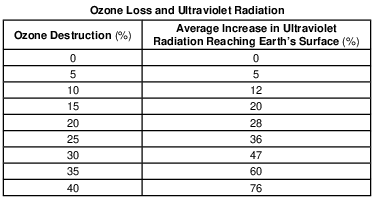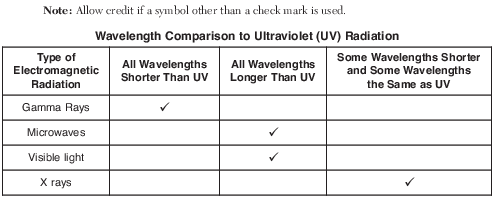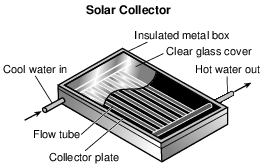Topic: Electromagnetic Energy
Electromagnetic Energy
Most of the electromagnetic energy radiated from Earth’s surface is in the form of
(1) ultraviolet rays
(2) infrared rays
(3) gamma rays
(4) x rays
In which region of the electromagnetic spectrum is most of Earth’s outgoing terrestrial radiation?
(1) infrared
(2) visible
(3) ultraviolet
(4) x rays
Fluorescent Minerals
All minerals have the ability to reflect visible light. Only about 15% of minerals have an interesting physical property known as fluorescence. These minerals have the ability to temporarily absorb a small amount of electromagnetic energy and, an instant later, release a small amount of energy of a different wavelength. This change in wavelength causes a temporary color change of the mineral in the eye of an observer. The color change of fl uorescent minerals is most spectacular when the minerals are placed in darkness and exposed to electromagnetic energy shorter than visible light.
A former zinc mine in New Jersey is one of the most famous sources of fluorescent minerals in the entire world. Zincite and willemite were two of the zinc ores mined there. It was later discovered that more than 91 minerals in this region displayed fluorescence under shortwave electromagnetic energy.

Which two forms of electromagnetic energy are used to produce the most spectacular fluorescence when placed in darkness?
(1) microwaves and x rays
(2) microwaves and infrared
(3) ultraviolet and x rays
(4) ultraviolet and infrared
Cosmic Microwave Background Radiation
In the 1920s, Edwin Hubble’s discovery of a pattern in the red shift of light from galaxies moving away from Earth led to the theory of an expanding universe. This expansion implies that the universe was smaller, denser, and hotter in the past. In the 1940s, scientists predicted that heat (identified as cosmic microwave background radiation) left over from the Big Bang would fill the universe. In the 1960s, satellite probes found that cosmic microwave background radiation fills the universe uniformly in every direction, and indicated a temperature of about 3 kelvins (K). This radiation has been cooling as the universe has been expanding.
Cosmic microwave background radiation is classified as a form of electromagnetic energy because it
(1) travels in waves through space
(2) moves faster than the speed of light
(3) is visible to humans
(4) moves due to particle collisions

This Doppler radar instrument transmits electromagnetic energy in the form of microwaves. Some microwave wavelengths are between the wavelengths of
(1) gamma rays and x rays
(2) infrared and radio waves
(3) ultraviolet and infrared
(4) x rays and ultraviolet
Which type of electromagnetic radiation has the shortest wavelength?
(1) ultraviolet
(2) gamma rays
(3) radio waves
(4) visible light
Most of which type of electromagnetic radiation is given off by Earth’s surface at night?
(1) gamma rays
(2) ultraviolet light
(3) visible light
(4) infrared rays
In which portion of the electromagnetic spectrum is the maximum intensity of Earth’s outgoing radiation?
(1) visible light
(2) gamma rays
(3) infrared
(4) ultraviolet
Which type of electromagnetic radiation listed below has the longest wavelength?
(1) infrared
(2) ultraviolet
(3) red visible light
(4) violet visible light

On the table in the image provided, place one check mark in each row to compare the relative wavelengths of other types of electromagnetic radiation to ultraviolet (UV) radiation. [1]
Wavelength Comparison to Ultraviolet (UV) Radiation

Allow 1 credit for a correctly completed chart as shown below.
• 

Explain why the flow tubes and collector plate inside the solar collector are black in color. [1]
Allow 1 credit. Acceptable responses include, but are not limited to:
• — Black is a good absorber of electromagnetic energy/sunlight/insolation.
• — Black is a good absorber and a good radiator.
• — Dark colors take in radiation better than light colors.
• — Black absorbs more energy.
• Note: Do not allow credit for “black absorbs energy” alone because all colors absorb energy. Black
• is just a better absorber of that energy.
